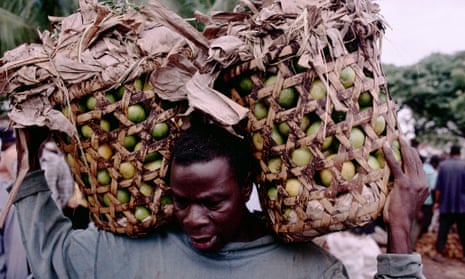Every day in low-income countries throughout the world, tons of fresh fruit and vegetables fail to reach their destinations or become damaged and inedible along the way. By contrast, highly processed foods – likely to include large amounts of fat, sugar or preservatives – reach these same destinations, ready to be eaten by people in need of food. This simultaneous availability of less healthy processed food and shortage of nutritious food is a key factor in the growing combination of undernutrition and obesity throughout many low-income countries.
Picture what a typical vegetable must go through to reach a person in a low-income country. Much of the developing world lacks the farms or the conditions to grow edible vegetables, so they must be imported from far away. Once the vegetable is harvested, it has a limited amount of time to travel great distances before spoiling. It must navigate through a complex series of locations, vehicles, equipment, people and processes that relay it all the way from the farm to the consumer. Along the way, the relatively fragile vegetable must remain protected from high temperatures, damaging weather, bruising, insects, worms, and various other hazards.
Major parts of these agricultural supply chains are unreliable, unsafe, outdated and even absent, especially once the vegetable arrives a low-income country. Vehicles may be broken or not have enough room or the right equipment. In fact, these vehicles may serve numerous other purposes so may not even be available or may be carrying toxic materials such as chemicals or excrement. Frequently, there is unnavigable terrain, leaving people to travel on bikes, animals, or foot. Storage locations and equipment may be dilapidated and unsafe. The supply chain employs poorly paid workers who may not have the training or motivation to take care of the foodstuff. And even if the vegetable were to successfully traverse all these obstacles, the final destination may not properly refrigerate, clean and prepare it for safe consumption.
By contrast, highly processed food have a much easier journey. Take cookies as an example: preservatives and protective packaging can help them withstand adverse conditions, assault by insects, worms or other predators, and other potential damage while maintaining their original, attractive form. The cookie manufacturer has invested time, effort, and resources to design and run a special supply chain. Compared to the vegetable, the cookies are glamorous celebrities: enhanced by plastic surgery and traveling business class all the way. Once the cookies reach their destination, they are ready to eat. No preparation is necessary, and they still taste great.
Over the past decade, many low-income countries have enjoyed growing access to food – but not necessarily healthy food. Empty wrappers, bags, bottles, and boxes of well-known brands of processed foods now appear in even the most remote parts of the world. When highly processed foods reach their destination and fruits and vegetables do not, a population has little choice over which they eat. Until agricultural supply chains for low-income countries are improved, fresh fruits and vegetables may have little chance against their hardier and less healthy competitors.

So what can be done to help transport fruit and vegetables around the world? Until the past few years, vaccines have faced a similar problem. At the beginning of this decade, even though various donor countries, vaccine manufacturers and other organisations such as the Bill and Melinda Gates Foundation and Gavi, had been investing heavily into developing new vaccines and helping countries purchase them, studies in countries such as Niger showed that many were being lost in supply chains, unable to reach their destinations. Various storage and transport bottlenecks meant that billions of dollars’ worth of vaccines was going to waste, resulting in suffering and deaths that could have been prevented.
These realisations led to much greater focus on – and more resources being committed to – evaluating and improving vaccine supply chains. At the same time, innovative technologies have emerged, such as new vaccine storage equipment and computational simulation modelling to test different supply chain improvement strategies. The result has been a major redesign of vaccine supply chains, many of which were designed over 30 years ago.
For example, after modelling showed the potential benefits of a redesign, Benin has begun to change its supply chain so that vaccines do not have to travel through as many storage locations and transport vehicles to reach clinics. Major players in the vaccines industry, such as the Gates Foundation, Unicef, Gavi, and the World Health Organisation, are now recruiting experts and establishing training programmes in supply chain management.
Of course, fruit and vegetables are not the same as vaccines. But while the exact same approaches may not work, similar general principles (improving training and introducing new methods, approaches and technology) could well improve agricultural supply chains. For example, new designs such as establishing more farms in low-income countries could reduce the distance that fruit and vegetables have to travel.
The advancement of vaccines has taught us that creating a smooth path is crucial in delivering a healthy product – especially within the developing world. Fresh fruit and vegetables currently face a much more difficult path and have many more requirements than highly processed foods. But better understanding and facilitating this could well play a major role in improving health and wellbeing across the world.
Bruce Y. Lee is director of the Global Obesity Prevention center at Johns Hopkins. Follow @GlobalObesity on Twitter.
Join our community of development professionals and humanitarians. Follow@GuardianGDP on Twitter.

Comments (…)
Sign in or create your Guardian account to join the discussion